Interesting Science Videos
What is Penicillin?
Alexander Fleming in September 1928 accidentally discovered Penicillin. He found that the fungus, Penicillium notatum prevented the growth of bacteria, Staphylococcus spp.. Later Clutterbuck and his colleagues in 1932 studied the nature of Penicillin and found it as an organic acid that dissolves into the organic solvent at low PH. Chain et al in 1940 cultured fungus and extracted powdered form of Penicillin. Later, at the time of the second world war, Penicillin production was done and an adequate amount was produced to treat wounded people. P. notatum gave poor results so, other species of Penicillium were tested. As compared, P. chrysogenum NRRL 1951 gave good results which were induced by UV and other mutagenic chemicals. These selected strains produced a huge amount of Penicillin and inhibit the growth of the Oxford strain of Staphylococcus aureus. Czapek-Dox broth was used for the culture of P. notatum. Later, casein, beef extract were added for the better yield of penicillin which will be an aid in production. In 1949 chemically produced mediums like phenylacetic acid ethyl amine etc by maintaining the PH and addition of buffering agents like Calcium carbonate and also maintain the temperature.
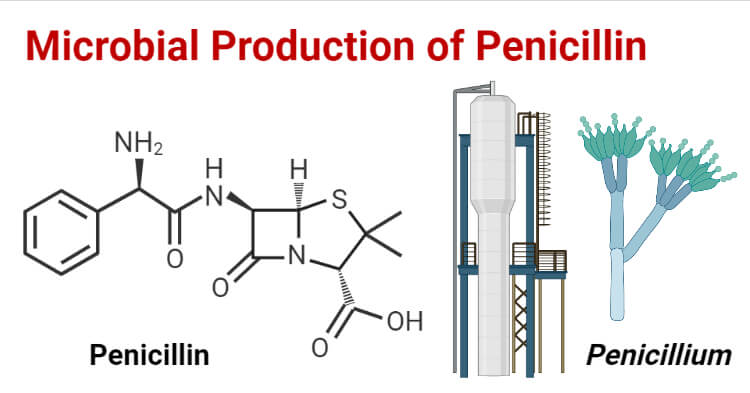
Types of Penicillin
Two types of Penicillin are Penicillin G (Benzyl Penicillin) and Penicillin F. Penicillin F is also known as Phentenyl Penicillin. Natural Penicillin are obtained as sodium or potassium salts. These classes of antibiotics are used in treating both Gram-positive and Gram-negative infections. Penicillin G are a narrow-spectrum antibiotic. Examples of Penicillins are Ampicillin, Cloxacillin, Oxacillin, Piperacillin, etc.
Structure of Penicillin
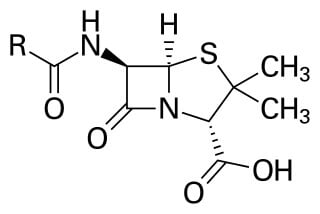
The structure of Penicillin includes a 4-membered β-lactam ring and thiazolidine ring. Β-lactam ring contains an amide bond that is broken in an acidic and alkaline medium and that bond is hydrolyzed by beta-lactamase which is synthesized by many bacteria. Naturally occurring penicillins have different structure which is separated by R groups. The basic structure attaches to the N-acyl group in the substituted amino group. Mainly, Penicillin is categorized as natural and semisynthetic.
Biosynthesis of Penicillin
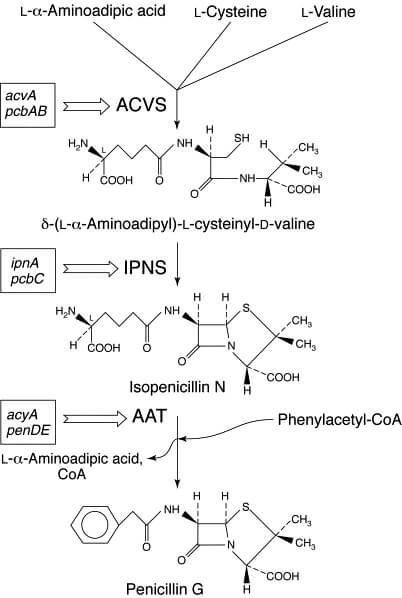
Figure: Biosynthesis of penicillin G. Image Source: M A Peñalva et al. 1998.
Penicillins yield is done commercially by using P.chrysogenum. Although the fungus was found earlier in 1928, these biosynthesis processes were concluded later. Penicillin biosynthesis is described into three main steps; catalytic step, oxidative, and exchange of different chains.
- The catalytic step involves an ACV synthetase enzyme that condenses the lateral chain of cysteine, valine, and alpha aminoadipate into tripeptide ACV.
- In the second step, tripeptide ACV forms a bicyclic ring by oxidative ring closure. Isopenicillin N synthase is involved resulting in isopenicillin N which is a bioactive intermediate in the pathway.
- The third step involves the exchange of L-aminoadipate. Acyl-CoA synthetase and Acyl-CoA racemase, a two enzyme system is involved that helps in converting isopenicillin N into Penicillin N.
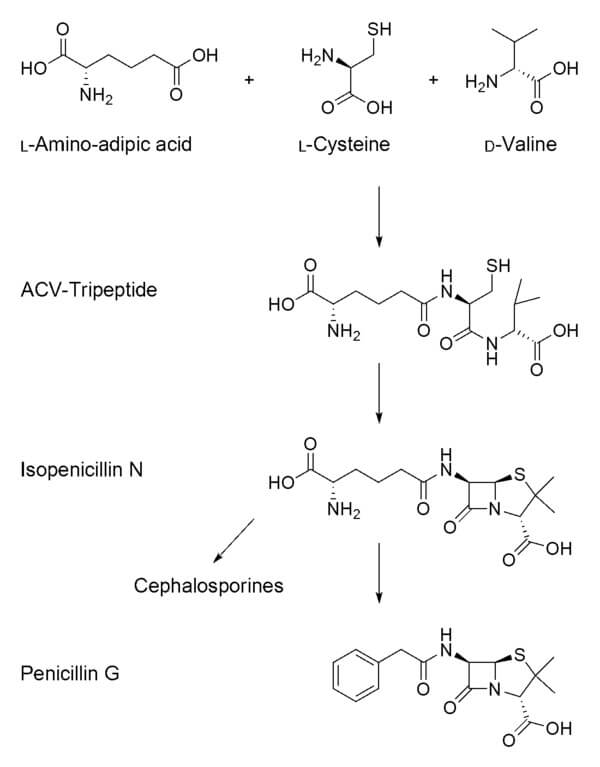
Figure: Penicillin biosynthesis. Image Source: Cacycle.
Penicillin Production Process
Penicillin production is done by fermentation process in a fermenter by agitating the culture of P.chrysogenum in a suitable condition. The whole process carried out is aerobic and the method involved is fed-batch.
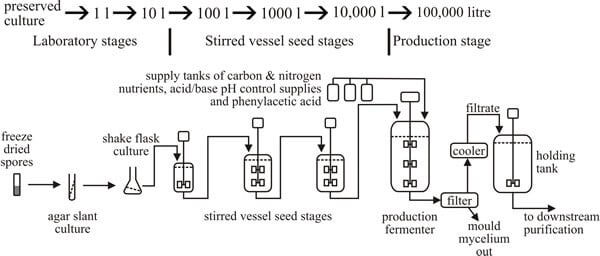
Figure: Outline diagram of current penicillin production by fed-batch submerged fermentation. The top panel shows the procedure for inoculum development. Image Source: David Moore.
This fermentation process is of Penicillin G which involves the following steps:
- 100ml medium with spores of P.chrysogenum strains is inoculated in Erlenmeyer flask and is incubated at BOD incubator by placing them on a rotatory shaker.
- After 4 days of incubation, the content along with two liters of medium is transferred into a flask that contains four liters and again incubates for two days.
- Then, the content is transferred into a stainless tank containing 500 ml of the medium that provides suitable conditions for fungal growth.
- After three days of incubation, the content is used for inoculation and kept in a fermentor that is well equipped with optimum conditions.
- The content is filtered after six days of incubation which contains penicillin.
- The penicillin is extracted into amyl or butyl acetate and is transferred into an aqueous solution with phosphate buffer.
- Acidify the extract and again re-extract penicillin into butyl acetate
- In the solvent extract potassium acetated is added to a crystallization tank to crystallize as a potassium salt.
- Crystals were recovered and further sterilization of salt is done.
Application/Uses of Penicillin
- Used in treating infections caused by both Gram-positive and Gram-negative bacteria like respiratory tract infections, throat, mouth, gum, and urine infections and also used in treating bacterial endocarditis.
References
- Peñalva MA, Rowlands RT, Turner G. The optimization of penicillin biosynthesis in fungi. Trends Biotechnol. 1998 Nov;16(11):483-9. doi: 10.1016/s0167-7799(98)01229-3. PMID: 9830157.
- Chand S and Dr. Dubey RC (1993). A Textbook of Biotechnology. 372-375.
- From, https://www.biologydiscussion.com/medical-microbiology/penicillins-discovery-and-structure-antibiotics/55902.
- From, https://www.news-medical.net/health/Penicillin-Biosynthesis.aspx
- From, https://www.onlinebiologynotes.com/penicillin-production-commercially-by-fermentation-biotechnology/.
- https://www.yourarticlelibrary.com/science/chemical-structure-and-fermentation-process-of-penicillin-by-alexander-fleming/23343- 1%
- https://www.ramauniversity.ac.in/online-study-material/fet/biotechnology/btech/vsemester/fermentationtechnology/lecture-10.pdf- 1%
- https://www.storyboardthat.com/innovations/penicillin- 1%
- https://www.sciencedirect.com/science/article/pii/S0006291X19309325- 1%
